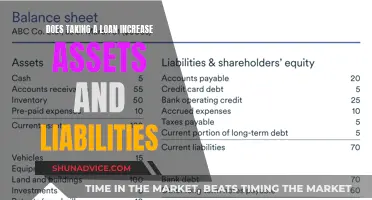
An adjustable-rate mortgage (ARM) is a loan with an interest rate that changes over time. Unlike fixed-rate mortgages, the interest rate on an ARM is subject to change periodically. The ARM has four components: an index, a margin, an interest rate cap structure, and an initial interest rate period. The index is a benchmark rate that fluctuates based on market conditions and the margin is a number of percentage points set by the lender. When the initial rate period ends, the index and margin are added together to form the new interest rate, which is then subject to any rate caps.
| Characteristics | Values |
|---|---|
| Full Form | Adjustable Rate Mortgages |
| Type of Mortgage | Variable-rate mortgage |
| Interest Rate | Changes over time |
| Components | Index, margin, interest rate cap structure, and initial interest rate period |
| Index | Benchmark interest rate to determine the pricing |
| Index Options | 1. Constant Maturity Treasury (CMT) index; 2. 1-year London Interbank Offered Rate (LIBOR) |
| Caps | 1. Annual; 2. Life-of-the-loan |
| Margin | Number of percentage points by which the loan rate can increase after the fixed-rate period |
| Ideal For | Borrowers who plan to sell the home or pay off the loan within a few years |
What You'll Learn
- Adjustable-rate mortgages (ARMs) are a type of home loan with an interest rate that changes periodically
- The index is an interest rate that fluctuates with the market
- The margin is the number of percentage points added to the index by the lender to set the interest rate
- The fully indexed rate is equal to the margin plus the index
- The benchmark index dropping means the interest rate will decrease after the fixed period

Adjustable-rate mortgages (ARMs) are a type of home loan with an interest rate that changes periodically
An adjustable-rate mortgage (ARM) is a loan with an interest rate that changes over time. Unlike fixed-rate mortgages, which have the same rate for the life of the loan, ARMs have a rate that moves up or down after an introductory period. The introductory period for an ARM typically lasts three, five, seven, or ten years, during which the interest rate is fixed. After this period, the interest rate adjusts periodically, usually once or twice a year, based on market conditions.
The interest rate for an ARM is tied to a benchmark or index, such as the Secured Overnight Financing Rate (SOFR) or the London Interbank Offered Rate (LIBOR). The lender chooses the index for the loan when the borrower applies for it, and this generally doesn't change after closing. The margin, which is the number of percentage points added to the index to set the interest rate, is also set by the lender and included in the loan agreement. The fully indexed rate is calculated by adding the margin to the index.
ARMs typically start with a low fixed-rate during the introductory period, making the initial monthly payments more affordable for borrowers. However, once this period ends, the interest rate and monthly payments can increase or decrease, depending on the movement of the index. This means that borrowers with ARMs may face higher monthly payments in the future if interest rates rise.
ARMs are generally better suited for borrowers who plan to sell the home or refinance the loan within a few years. This way, borrowers can take advantage of the low introductory rate and end the mortgage before the rate adjusts. ARMs also offer budget flexibility, as the lower monthly payments at the beginning can free up funds for other expenses or investments.
It is important to note that the interest rates for ARMs can fluctuate significantly, and there is a risk of unaffordable payments if the balance rises too much. Additionally, interest rates are unpredictable, and borrowers should be prepared for potential increases in the future. Overall, ARMs provide flexibility and the potential for lower payments but come with the risk of higher payments down the road.
Teach for America: Loan Forgiveness and You
You may want to see also

The index is an interest rate that fluctuates with the market
An adjustable-rate mortgage (ARM) is a loan with an interest rate that changes over time. The index is a benchmark interest rate used by lenders to determine the pricing of adjustable-rate mortgages. The index fluctuates periodically based on general market conditions. When the initial interest rate period expires, the new interest rate is calculated by adding a margin to the index.
The index figure can move up or down, and the interest rate is adjusted accordingly. The lender decides which index the loan will use when the borrower applies for the loan, and this choice generally remains the same after closing. The margin is the number of percentage points added to the index by the lender to set the interest rate on an ARM after the initial rate period ends. The margin is set in the loan agreement and remains unchanged after closing.
The fully indexed rate for an ARM is equal to the margin and the index added together. The margin amount depends on the specific lender and loan. It is important to understand how an ARM index works when deciding whether an ARM is appropriate based on its short- and long-term affordability.
The interest rate cap structure of an ARM provides some protection from large interest rate swings. There are two types of caps: annual and life-of-the-loan. The annual cap restricts how much the interest rate can change in a given year, while the life-of-the-loan cap limits the maximum and minimum interest rates payable over the life of the mortgage.
Understanding Loans: Impact on Assets and Liabilities
You may want to see also

The margin is the number of percentage points added to the index by the lender to set the interest rate
An adjustable-rate mortgage (ARM) is a loan with an interest rate that changes over time. The interest rate of an ARM is tied to an index and a margin. The index is an interest rate that fluctuates with the market. The margin is a set of percentage points that the lender determines and adds to the index to set the interest rate for the ARM. This is known as the fully indexed rate.
The margin is set by the lender when the borrower applies for the loan. The margin is disclosed in the loan agreement and remains fixed for the duration of the loan. The margin can vary between lenders, so it is advisable to compare different lenders' margins before deciding on a loan. Additionally, borrowers may be able to negotiate a lower margin with the lender.
The index and margin are added together to determine the interest rate of an ARM after the initial interest rate period expires. The initial interest rate period of an ARM is typically a few years, during which the borrower enjoys a low, fixed interest rate. Once this period ends, the interest rate begins to adjust periodically based on market conditions.
The changes in the index and the margin determine the changes in the interest rate and the borrower's monthly payments. If the index rate rises, the interest rate and monthly payments will increase. Similarly, if the index rate falls, the interest rate and monthly payments may decrease. It is important to note that the interest rate adjustments are based on market conditions and are not influenced by the borrower's personal financial situation.
The Fed's Lending Power: Individual Access Explored
You may want to see also

The fully indexed rate is equal to the margin plus the index
An adjustable-rate mortgage (ARM) is a loan with an interest rate that changes over time. Unlike fixed-rate mortgages, where the interest rate remains the same for the life of the loan, the interest rate on an ARM will change periodically. The initial interest rate of an ARM is usually lower than that of a fixed-rate mortgage.
The ARM index is the benchmark interest rate to which an adjustable-rate mortgage (ARM) is tied. The index underlying the ARM is variable, while the margin is constant. The index is an interest rate that fluctuates periodically based on general market conditions. The margin is a number set by the lender when the borrower applies for the loan.
The fully indexed rate for an ARM is equal to the margin and the index added together. This is the rate that is applied to the loan's monthly payments. When the initial interest rate period expires, the new interest rate is calculated by adding a margin to the index. This new interest rate is subject to any rate caps.
The margin is the number of percentage points added to the index by the mortgage lender to set the interest rate on an ARM after the initial rate period ends. The margin is set in the loan agreement and remains the same throughout the life of the loan. The margin amount depends on the particular lender and loan.
Tennessee's State Library: Borrowing System Explained
You may want to see also

The benchmark index dropping means the interest rate will decrease after the fixed period
An adjustable-rate mortgage (ARM) is a loan with an interest rate that changes over time. The interest rate on an ARM is tied to a benchmark interest rate known as the ARM index, which fluctuates with general market conditions. When the benchmark index drops, the interest rate on the ARM will also decrease.
The ARM index is used by lenders as a reference point to determine the pricing of adjustable-rate mortgages. The index figure moves up or down, and the interest rate on the loan is adjusted accordingly. This means that if the benchmark index drops, the interest rate on the ARM will also decrease after the fixed-rate period ends.
It's important to note that the interest rate on an ARM is also influenced by the margin, which is a number of percentage points set by the lender when the loan is applied for. The margin remains fixed throughout the loan and is added to the index to determine the new interest rate when the initial teaser rate expires.
ARMs typically have an initial fixed-rate period, during which the interest rate remains constant. After this period ends, the interest rate becomes adjustable and can increase or decrease based on the movements of the benchmark index and the margin. For example, a 5/1 ARM has a fixed rate for the first five years, followed by an adjustable rate that can change annually.
While a dropping benchmark index can lead to a decrease in the interest rate on an ARM, it's important to consider the potential risks associated with adjustable-rate mortgages. Borrowers opting for ARMs face future risks that other loans do not, as their payments may increase significantly if market interest rates rise. Additionally, refinancing an ARM to take advantage of declining interest rates can be time-consuming and incur high closing costs.
Tennessee Harp Loans: What You Need to Know
You may want to see also
Frequently asked questions
An adjustable-rate mortgage (ARM) or variable-rate mortgage is a loan with an interest rate that changes periodically with the broader market.
The interest rate of an ARM loan is determined by adding the ARM index and the ARM margin. The ARM index is a benchmark rate that fluctuates based on market conditions. The ARM margin is a number of percentage points set by the lender when the loan is issued.
The interest rate of an ARM loan typically changes every six months after the introductory period.







